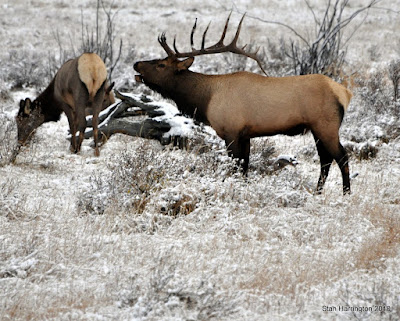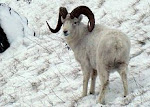Friday, November 26, 2010
The "Bear"
Friday, November 19, 2010
Elk
 "Bugling Bull"
"Bugling Bull"
 JASPER NATIONAL PARK ~ CANADA
This particular "Royal" had a herd of eleven cows with him and provided me a couple of hours of entertainment in photographing him and his herd.
JASPER NATIONAL PARK ~ CANADA
This particular "Royal" had a herd of eleven cows with him and provided me a couple of hours of entertainment in photographing him and his herd.
 ~ MONTANA ~
~ MONTANA ~
Tuesday, November 9, 2010
The "Grand Slam"


Rocky Mountain Big Horn Ram ~ Black Hills, South Dakota

The Stone Sheep and the Dall Sheep are also related according to my research. Each of them similar in size and horn curl similar. The primary difference is their coloration, each of them taking on the camouflage color of the background of the area in which they live. Both species live at the higher altitudes during the summer, moving down the slopes as the winter snow accumulates and covers their feeding areas. The Dall Sheep can be found throughout Alaska and northern Yukon Territory. The Stone or Stone's sheep is found in the Yukon Territory and occasionally in northern British Columbia.
Dall Ram ~ Turnagain Arm, Alaska


Monday, November 8, 2010
Natural Camouflage
Desert Big Horn Ram ~ Area Of Beatty, Nevada

Thursday, November 4, 2010
North Dakota ~ "The Wild Ones"
 "I Have Been Discovered"
"I Have Been Discovered"
 "Ears Back, Sounding The Alarm, Swishing The Tail ~ Warning Signs"
"Ears Back, Sounding The Alarm, Swishing The Tail ~ Warning Signs"
 "Pawing The Ground ~ Turning The Herd"
"Pawing The Ground ~ Turning The Herd"


Monday, November 1, 2010
Journey Is Over
 Thompson Falls, Montana
Since my original visit in September, the contractors had the time to complete the construction of two bridges in the Little Thompson River canyon. This provided additional access into the canyon and forests of this area. It is a beautiful area, heavily treed with Ponderosa Pine and Siberian Larch.
Thompson Falls, Montana
Since my original visit in September, the contractors had the time to complete the construction of two bridges in the Little Thompson River canyon. This provided additional access into the canyon and forests of this area. It is a beautiful area, heavily treed with Ponderosa Pine and Siberian Larch.
 Since my first visit, a Rocky Mountain Big Horn Ram had moved down and claimed the herd of ewes that I had photographed earlier in the fall. He was not concerned with my presense and allowed me to get in close to him. It is early into the rut, I am not sure if he has the armament to ward off the larger rams in the area.
Since my first visit, a Rocky Mountain Big Horn Ram had moved down and claimed the herd of ewes that I had photographed earlier in the fall. He was not concerned with my presense and allowed me to get in close to him. It is early into the rut, I am not sure if he has the armament to ward off the larger rams in the area.

































